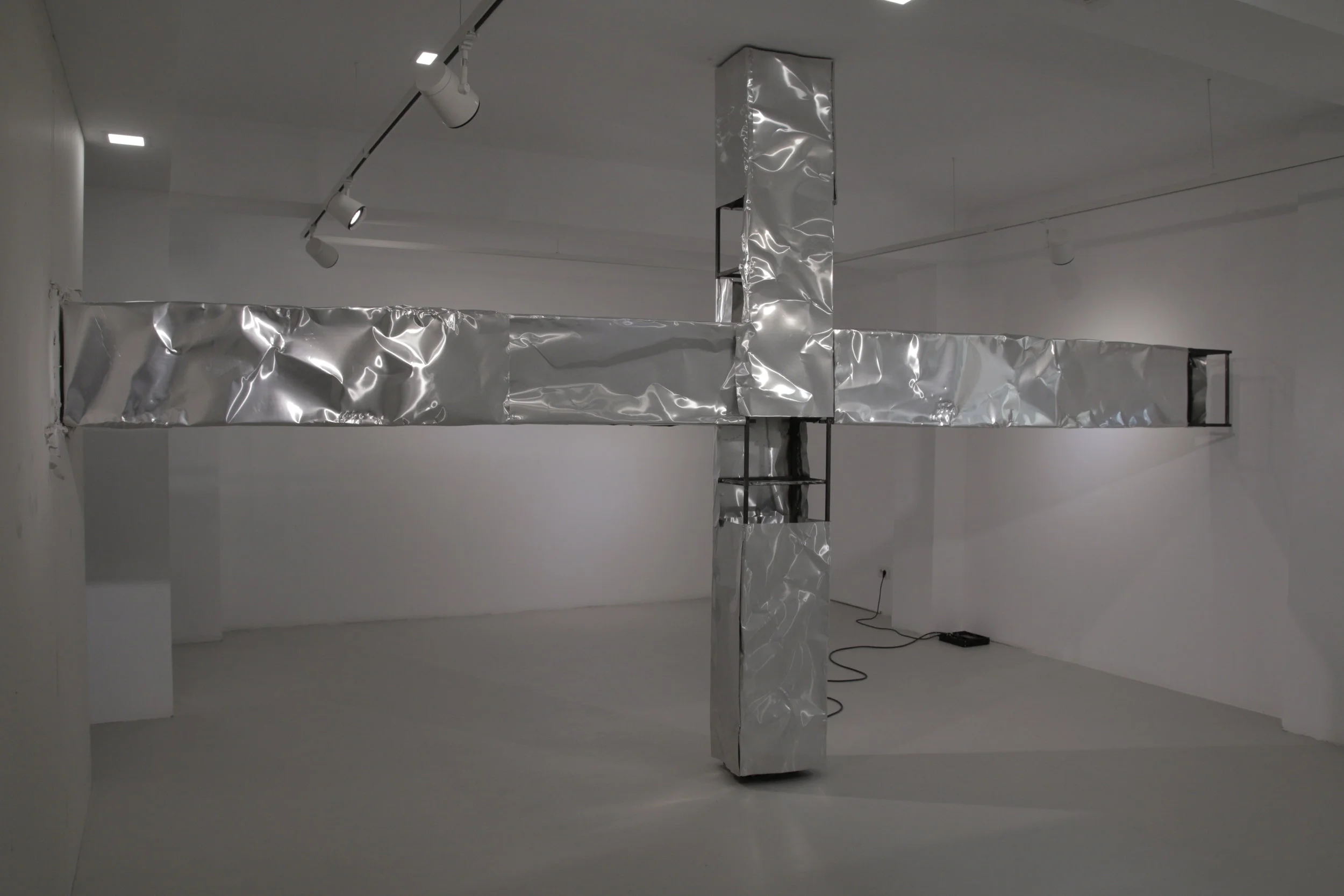Project 4
Omul Mulțime/Hombre Masa - Lolo & Sosaku
Curated by Laura Tammen.
July 22nd - August 20th 2017 - Borderline Art Space, and the Palace of Culture, Iasi, Romania
For our fourth project, we were very excited to work on a collaboration with Lolo & Sosaku on a two part exhibition in Iasi, Romania. Again, we had the good fortune of working with Borderline Art Space but additionally the Palace of Culture.
Produced in Iasi by Barcelona based artists, Lolo & Sosaku, "Omul mulțime/Hombre masa" was an exhibition in two parts. Taking place simultaneously in the Palace of Culture and Borderline Art Space, the show aimed to connect the spaces by reflecting on their social scope, inherent connotations, or adapted expectations, as well as its possibilities.
"Dancer (Palace)" a large-scale parallelogram shaped kinetic sculpture, contracts and unfolds in steady intervals in an continuous interplay of force and counterforce, action and reaction. Harmonising with the neo-gothic architecture of the Palace of Culture, it classifies itself within the building’s history and conforms to its expectations of its representative space. The work expresses inspiration in movement, interpreting
dance as a ritual, a custom and a form of social interaction, but due to its dimensions and rigidity in
movement, it appears cold and distant, isolating itself within its inscribed circle.
As an antithesis to this, the sound-piece "Hombre Masa" pervades the entire exhibition at Borderline Art Space. An ensemble of sound recordings carried out during the construction of the sculpture and merged with recordings made in public spaces, "Hombre Masa" reflects on its social components, especially on the collaborative creation process with local welders.
The centrepiece of the exhibition at Borderline Art Space, is a large rotating asymmetrical cross, without any
religious implications. Moving slowly, the horizontal bar hits the gallery walls and provokes friction
between the metal material and the limits of the space. All the while producing sounds and leaving
erosive scratches on the walls. The cross serves as a kind of revolving door or turnstile - through which the spectator, after observation, acceptance and awareness, is able to enter the gallery after having overcome its obstacles.
As a rotating X mark - an indicator or common concept of negation - the cross states our presence in time
and space. Seemingly at odds with its environment, the work imposes on the space not only with its
obstructive nature and ambitious size, but also with the physical corrosion evoked on the walls. These elements are again part of the two iron plates, "Esquema I" and "Esquema II", exhibited at the entrance of the gallery and are graphic interpretations of the sculpture’s movement, its form and friction. On their plain surface, they display deep marks produced with the same tools used to create the sculptural intervention.
The works exhibited at Borderline Art Space and the Palace of Culture unite as a monument to conjoint sacrifice and labour - a necessary conscious presence within history and evolution as an outcome of social values like cooperation and collaboration that go beyond conformity and complacency - similar to Ortega y Gasset’s concept of the "hombre masa". The "hombre masa“ (mass man) is described in his essay "Revolt of the Masses" (1930), wherein he examined the political and social crisis of Europe and of Western civilisation in general, which is extremely pertinent in this time of hyper-democracy. The hombre masa is a warning against the conformity of the masses and their tendency to negate individual creativity and freedom, an intensifier of crushing mass movements of ideologies that have dominated Europe and the world for a considerable time - and remains relevant today.
Test maquette for Omul mulțime
Lolo & Sosaku's first sketches for Omul mulțime/Hombre masa
Since its beginnings in 2004, Barcelona based artist duo Lolo (Buenos Aires, 1977) and Sosaku (Tokyo,
1976) has focused on an experimental merging of art and sound. The result is a ceaseless investigation of sound carried out through alternative, non-traditional means. In 2009 the artists started to build their own "instruments", which emit subtle sound evoked through fraction and collision of different elements /materials. Over the past eight years, Lolo & Sosaku "instruments" have gone through a respectable transition: from small, fragile hanging mobile sculptures, to more solid, bigger works grouped in sonic-sculptural-installations or interventions in public space, which since 2013 are characterised especially through the implantation of motors and their autonomy.
Lolo & Sosaku’s work has been exhibited and performed, amongst others, at Museo Reina Sofia, Madrid (2009), Museu da Imagem e do Som, São Paulo (2010), Fundação Casa França Brasil, Rio de Janeiro (2011), Sónar, Barcelona (2012), Matadero, Madrid (2013), Fundació Gaspar, Barcelona (2016), Festival Bien Urbain, Besançon, France (2016) and the Power Station of Art, Shanghai (2016). Hombre Masa represents their first solo show in Romania.


























